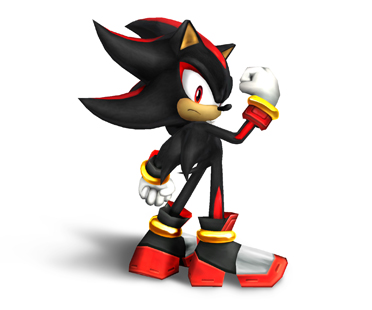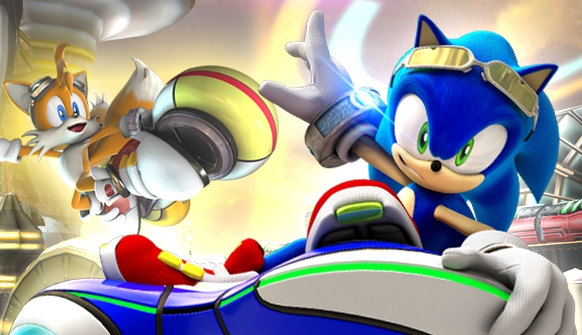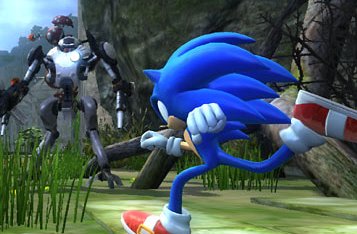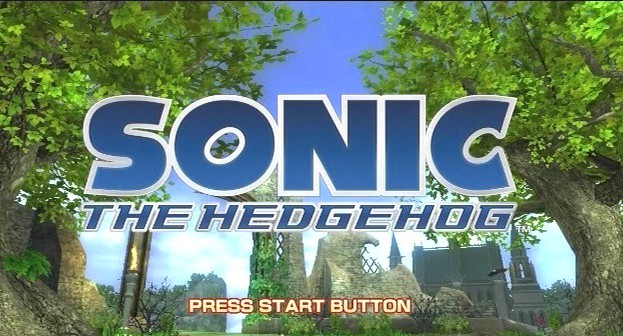Sonic Adventures (Act 9)
What happened when Sonic Heroes hit the shops was the last thing that anyone involved in the project expected. The game was a massive commercial success, continuing to do business long after its promotional window had closed. By the end of 2004, it stood as the fourth best-selling game of the year in Europe- no mean feat when the releases of Half Life 2 and Halo 2 are considered. Unfortunately, this sales victory had nothing but negative effects, ensuring that the ropy Renderware game engine would be recycled for the next title, and making certain that Sega would immediately put Takashi Iizuka and his team to work on the next Sonic game, when after two consecutive releases, they would far rather have taken a break from the franchise. The result of this directive was one of the most curious games in the series, in the form of Shadow The Hedgehog. Enviously eying the success of Grand Theft Auto, Sega were minded to try to give their mascot a harder edge, and the result was a very curiously structured piece that emphasised gunplay over the traditional spin attack. The intervention of Yuji Naka ensured that Sonic himself was kept at arm’s length from the experiment, with Shadow taking the lead role in a direct sequel to Sonic Adventure 2.
 |
The principle enemy in Shadow The Hedgehog is Black Doom, an alien warlord, and his army of minions, the Black Arms. The title opens with Shadow, still amnesic as established in Sonic Heroes, watching as the Black Arms bombard the planet. He’s soon contacted by their leader, who claims to be Shadow’s creator, and demands his assistance in subduing the earth. The Hero Side versus Dark Side concept from SA2 is given a far more direct gameplay role here- in each individual stage, Shadow must decide whether to help the earth’s defence team (typically a mixture of GUN troops and an existing character from the Sonic canon), the Black Arms or just work for his own interests by accumulating the chaos emeralds. The game follows a branching structure similar to Outrun, with Shadow’s completed objective for each level determining where he heads next and what direction the story takes. There were a considerable number of endings to the game, and the player was only granted access to the final section of the title after enough alternatives had been explored. The conclusion ties up all the threads relating to Shadow’s origin. Robotnik’s Grandfather struck a Faustian pact with Black Doom to gain the technology to create Shadow, with the resulting guilt being what drove him to the madness seen in Sonic Adventure 2. Shadow eventually decides that he will not assist Black Doom, and destroys the alien forces, before accepting a permanent job as GUN’s top agent. Although built using Sonic Heroes’ mess of an engine, the run and gun shooting gameplay doesn’t suffer quite as much from the flimsy technology. Compared to its predecessor, Shadow the Hedgehog is a better realisation of an inferior game.
 |
The release of Shadow The Hedgehog was supported by another effort from Dimps, this time on the Nintendo DS. Unlike the home systems title, however, Sonic Rush was universally well received. There was a greater emphasis on story than in the Gameboy Advance titles, with an extra-dimensional incursion kicking off proceedings. The new arrivals consist of Blaze the Cat, the second playable character, and her arch-enemy Eggman Nega, who is both more polite and more sinister that his normal counterpart. Blaze was an instant hit with fans and press alike, with her flame-generation powers providing a different gameplay style to the hedgehog without sacrificing his speed. On her world, she appears to combine the role of both Sonic and Knuckles, acting as guardian to the vital Sol Emeralds. The game succeeds by virtue of its striking art direction, with a memorable Greek tone in some of the levels. Also notable is a very atypical hip-hop soundtrack from Jet Set Radio composer Hideki Naganuma. The actual level layouts aren’t up to scratch, however, with many levels suffering from the same bland and unmemorable design that dogged Sonic CD. In contrast to this however, the half-pipe special stages feel wonderful in their touchscreen implementation, although they’re slightly too easy. As with most of the handheld outings, Sonic Rush sold by the ton.
Despite the mess of an engine that had powered Heroes and Shadow, Sega’s third attempt at multi-format development for the hedgehog proved much more competent, even if the game in question wasn’t worth the effort expended. Sonic Riders was a spiritual sequel to Sonic R, putting the cast atop racing hover boards, for a plot that concerns attempts by Robotnik and new street gang villains The Babylon Rogues to uncover an ancient treasure. The developers made a reasonable attempt at introducing depth, with the hoverboards having a large number of stats to tune, but failed to solve the core problems of combat multi-route racing games, leaving victories too heavily dependant on chance. A largely bland techno soundtrack adds to the lack of interest, but Sega seemed to be somewhat taken aback by the failure of the venture. A sequel had already been green-lit before the release of the title, with the Wii follow-up Sonic Riders: Zero Gravity eventually sinking without trace during 2008.
 |
With Heroes/Shadow creators Sonic Team USA on the point of mutiny, threatening to resign on mass if they were denied permission to develop the NiGHTS sequel that their leader had always yearned for, the Sonic franchise was effectively relocated back to Japan, being placed in the hands of the original Sonic Team. The finale of the ‘second wave’ of core titles had a rocky start, however. Since 1998’s Sonic Adventure, however, many staff had departed, being replaced by members of Sega’s defunct UGA studio. Development began on a custom-created multi format game engine for the new title, and an extremely impressive tech demo was shown behind closed doors in 2005, showing the Hedgehog facing off against a large number of enemies. With the technology coming together, Yuji Naka devised the concepts and themes for what would be his final venutre with his creation. Naka was one of a number of key figures that had fought frantically to keep Sega afloat when it faced the threat of bankruptcy in the first part of the decade, but considered his debit to the stabilised firm paid. Having obtained backing from Sega to fund his planned independant developer, Prope, he devised his parting shot to Sonic carefully, wanting to examine the question of how his creation would fare in the real world. The game would have a similar structure to Sonic Adventure, although it appears that at this point, Sonic was intended as the only playable character. In a reprise of the plot of Adventure, which pitted Sonic against a water elemental, this time the hedgehog would face a similar creature composed of flame. The story crafted would showcase both Sonic’s strengths and weaknesses, demonstrating his strength and dedication, but also his determination not to accept responsibility. A key part of this was his “relationship” with Elise, the ruler of the country in which the game was set. Despite the superficial trappings of romance, the plot makes clear that the deliberately cartoonish Sonic is incapable of commitment to another creature.
 |
Once Naka had departed to form his new organisation, however, the picture was muddied by his replacements. The diverting of Sonic The Hedgehog into a more expansive venture happened gradually, with the blue hedgehog being joined in the game by new character Silver and, finally, Shadow. Silver’s gameplay was ripped from a planned 3D version of a classic Sega franchise, with his telekinetic abilities operating in a context sensitive fashion as he strives to avert the creation of the apocalyptic future in which he lives. Despite the harder-edged styling of Shadow, he only deploys vehicles, not guns, playing like a more combat orientated version of Sonic. Interestingly, he’s able to pull off in-game the sort of teleport tricks that were present in the intro movie of his own title, but not the actual gameplay. Each of these three leads were joined by two “support” characters, who are playable for bonus levels and short sections of the core stages. Sonic and Shadow are joined by their teamates from Sonic Heroes, whilst Silver has a rag-tag collection of a 3D Blaze the Cat and Amy Rose. The implementation of these characters varies enormously- Knuckles and Amy are barely functional, but Blaze is wonderful to play as, being even faster than the star of the show. It’s worth noting that the Blaze shown here is “our” universe’s version of the character, residing in Silver’s future, as opposed to the parallel version of her début appearance. Blaze is killed off at the end of Silver’s story, but as the conclusion of the game neutralises its events (travelling back in time was the only way to save the world from the flame elemental), she’s presumably still alive. The other big success of the game was the implementation of Tails, with the addition of ranged attacks to the character finally making his scattershot flying function in 3D.
With Jun Senoue presumably lying in a darkened room after completing the soundtracks to the last two core games virtually single-handedly, the bulk of the game’s music was handled by the team of Hideaki Kobayashi, Mariko Nanba and Tomoya Ohtani. They make a reasonable first of the score, but the emphasis on atmosphere at the expense of memorable tunes is a slight misstep, for which the strong main theme only partly compensates. The usual vocal album and full OST followed the release of the game.
 |
The most frustrating aspect of Sonic The Hedgehog is that it’s so very nearly wonderful. The stages are well conceptualised, it offers a good variety of gameplay styles, it’s got an intricate and well-crafted story and the main theme tune is wonderful. The slight redesign of Sonic, giving him longer arms and legs, works superbly. Unfortunately, it was shot in the face by the replacements drafted in to exec-produce the project after Naka’s departure. The creators of the 3D Shinobi games were completely lacking in management skills, and resources were hopelessly misallocated, resulting in the horribly botched conversion of the game from the proprietary dev kits it was conceived upon to the reality of the Xbox 360 and PS3. In the behind-closed-doors demo of Kingdom Valley shown a year before release, Sonic moved at his “proper” speed, travelling at about twice the pace he managed in the finished game. The lack of management skills by the game’s producers also left dozens of bugs and glitches in the title, with the result that what should have been a fitting send-off for the Adventure style of game can only be played through gritted teeth. In one of the rare instances of the commercial performance of a Sonic game matching its quality, Sonic The Hedgehog sank without trace, and the Shinobi crew were removed from Sonic Team as a result. A candid blog post from former Sega employee Ben Andac reported that morale within the Team was at rock bottom, with the sweatshop conditions having disillusioned many staff that had been trapped working on the Sonic franchise for years. With Sonic Team USA being dissolved after finishing the Wii’s NiGHTS 2, its senior staff was folded back into the main Japanese operation, to ensure that there was an improvement in the managing of resources, while new studio head Tetsu Katano pledged to improve working conditions.
Next Time: Final stage! We’re not out of the woods yet, with the terminally-inept Wii titles still to work through. After that, we come right up to date with a look at Sonic Unleashed- the game I love and everyone else hates.
About this entry
- By Julian Hazeldine
- Posted on Sunday, August 09 2009 @ 7:17 pm
- Categorised in Games, Analysis
- Tagged with sonic the hedgehog, Sonic Adventures, Sega
- 4 comments

“Silver’s gameplay was ripped from a planned 3D version of a classic Sega franchise”
What was that, out of interest?
By Dave Wallace
August 16, 2009 @ 10:42 am
reply / #
Dave Wallace:
I can’t say I know, I’m afraid! I believe that programmers have talked about repurposing the code, but I’ve no idea what the game in question could have been. My knowledge of pre-1990 Sega material is a bit ropey, so my only thought is whether the “grab” mechanic of Silver’s telekensis could have come from a prototype version of Ristar. He’s known to have been an influence on the Unleashed Werehog’s stretching arms…
By Julian Hazeldine
August 16, 2009 @ 2:36 pm
reply / #
Shadow the hedgehog sucks. That game was horrible, just a smuch as Sahdow himself is.
By Bill
March 29, 2010 @ 5:04 pm
reply / #
It’s insightful comments like that which make me wish we hadn’t closed this site.
By John Hoare
March 29, 2010 @ 6:56 pm
reply / #